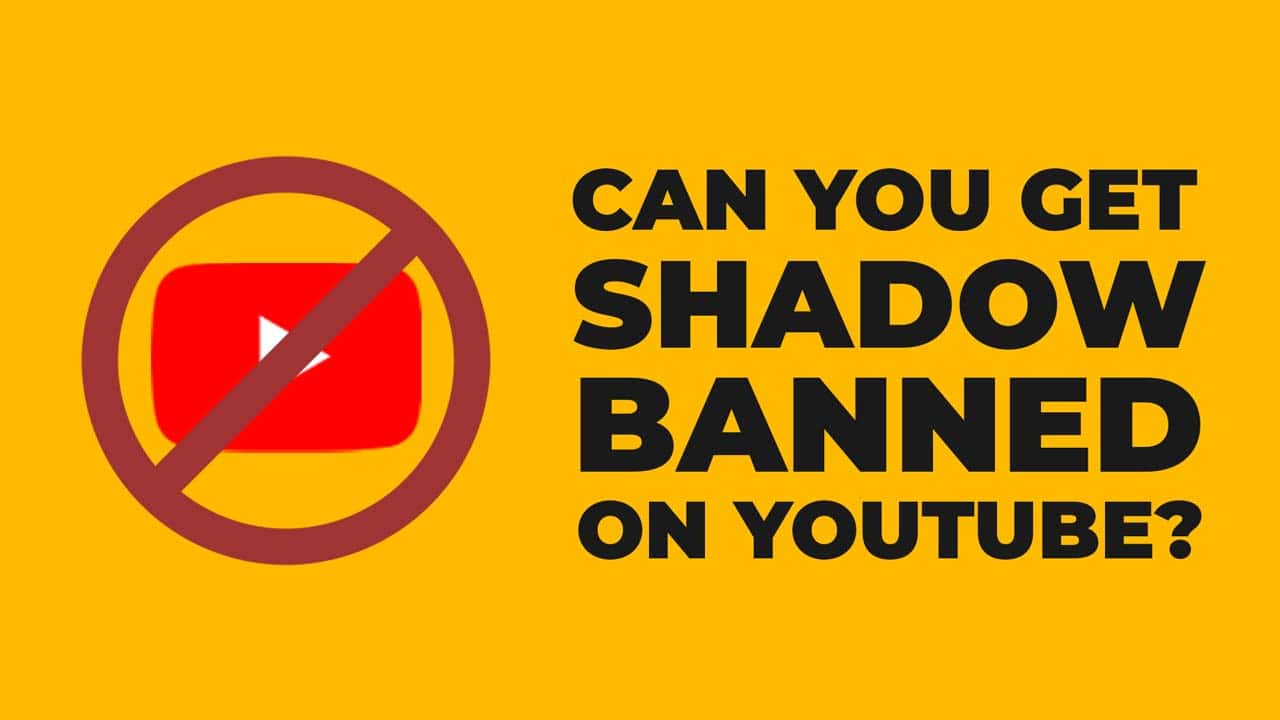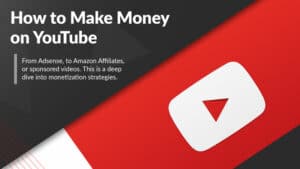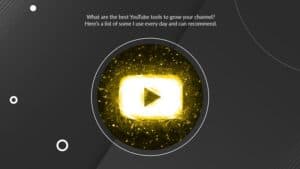Is there any truth to the claim that some channels can be “shadow banned” on YouTube? Or is it just because their videos suck and YouTube doesn’t want to recommend them…
Or, perhaps there ARE some reasons why a channel could be shadow banned, such as creating videos on taboo topics, refusing to adhere to YouTube’s Terms of Service, or even more nefarious reasons such as a secret Illuminati agenda from the government…
I’ve been on YouTube for 14 years, and out of the 8+ channels I’ve created and grown in that time (some of them reaching $22,000 per month), I’ve never seen it happen.
Alright, my tin foil hat is firmly planted on my head now. Let’s get started.
What is “shadow banning” on YouTube?
Shadow banning is defined as the practice of blocking or partially blocking a user or the user’s content from some areas of an online community in such a way that the ban is not readily apparent to the user, regardless of whether the action is taken by an individual or an algorithm.
On YouTube, some people claim that shadow banning takes the form of videos (or entire channels) never being recommended to viewers, or ever appearing in search results. Someone, or something supposedly decides which channels or videos are “acceptable”, and which are not.
Now, shadow banning does happen on some online platforms. For example, Tulsi Gabbard was allegedly shadow banned from Instagram due to her “controversial” content.
But what about YouTube?
Why Are These Channels Not Shadow Banned?
Firstly, let’s examine some channels that should almost certainly be “shadow banned” (if shadow banning is, in fact, real).
CrackerMilk
CrackerMilk is a comedy channel famous for it’s extremely bizarre and rude comedy sketch videos. Almost every single video contains swearing, adult themes, and other taboo topics such as the actors drinking paint (not actually real paint, at least I hope so…), sexual fantasies, drug use, or domestic violence.
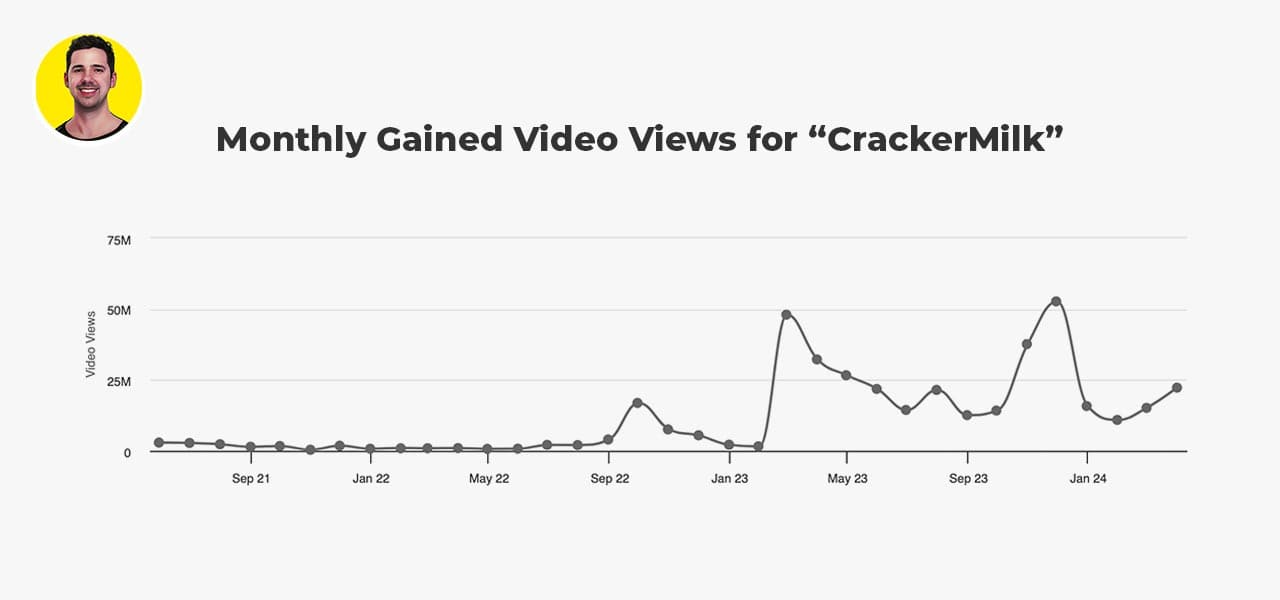
As you can see, CrackerMilk has been receiving 10-50 million views per month since October 2022.
This channel is not shadow banned.
Donut’s Raw Police Footage
Donut Operator is a former police officer who reacts to police bodycam footage on his channel. He has a second channel called Donut’s Raw Police Footage where he posts raw, uncut, and uncensored police bodycam videos.
Various videos on this second channel include bodycam footage from an active school shooting (including the shooter being killed by police), a police officer shot in the head with visible blood, and a man holding a machete to a woman’s throat before being shot multiple times by police.
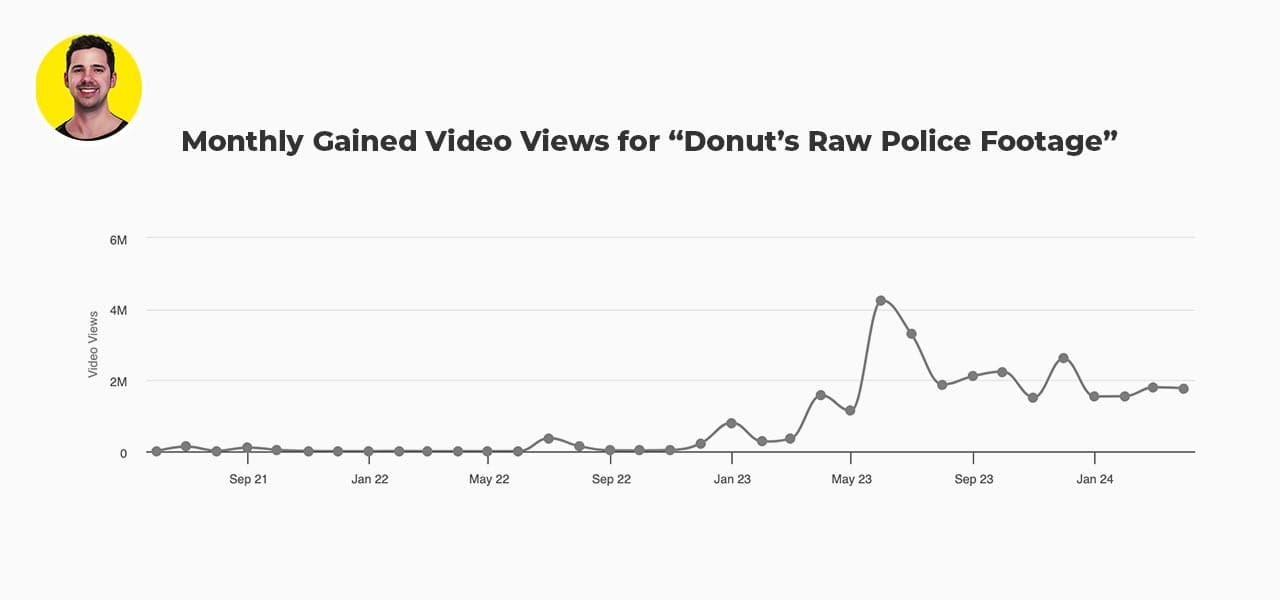
This channel receives on average 2 million views per month, and has done so consistently since May 2023. Side note – Donut Operator’s main channel showcases the same footage but with censoring. His content consistently shows in recommended and search results.
This channel is not shadow banned.
Controversial Channels
Next, we have controversial channels like Fresh and Fit who frequently feature porn stars, “toxic masculinity” and “misogynistic” personas like Andrew Tate (who is also officially banned from YouTube), and discuss extremely adult themes like prostitution, drug use, and violence.
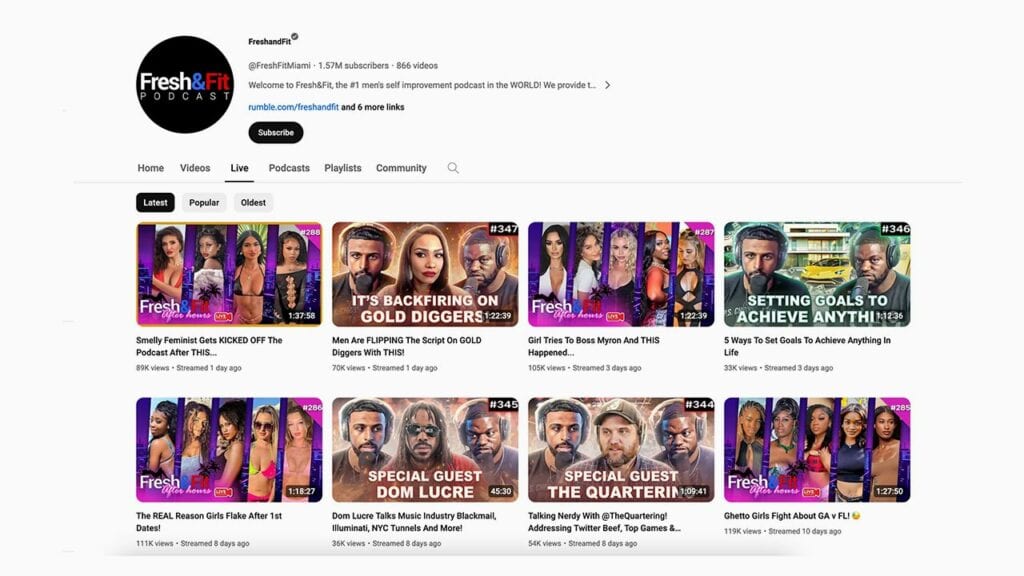
Cursing and racism including the use of racial slurs on these channels are commonplace.
Video clips featuring these channels or banned users like Andrew Tate are further spread by distribution channels like this, and this.
Alternatively, channels like NELK actively feature, discuss, or promote excessive alcohol consumption, drug use, gambling, pornography, and adult themes.
These channels are not shadow banned.
Side note: Although none of the channels I’ve mentioned so far are “shadow banned”, their YouTube Adsense monetization status is usually extremely limited due to the nature of their content.
However, they are able to make money via other avenues like sponsorships, affiliate marketing, or Patreon.
If these channels aren’t banned, what does this mean?
If shadow banning is truly real, those that claim they’re a victim of it must produce content more controversial than channels who joke about murder and drug use, show uncensored clips of blood, gore, and death, or post misogynistic or sexist content or upload videos of controversial and banned individuals like Andrew Tate.
So what’s more likely? Do those who claim to be “shadow banned” produce content more horrific, disturbing, and controversial than all of the above? Or do their videos simply just, suck…
Do videos really get shadow banned? Or do they just suck.
Despite all of this evidence, many people claim that their situation is different, and that YouTube is specifically out to get them and their channel. These are some of the most common arguments I hear:
My videos have performed really well in the past, but now they get barely any views.
There’s a saying in the investing world – past performance does not guarantee future results. And while we’re YouTubers and not Matthew McConaughey enjoying a cheeky lunch bump in Wolf of Wall Street, the saying still holds true for YouTube.
Perhaps viewers enjoyed your older videos, but the theme or content has become stale. Or maybe you just produce the same videos over and over again with no innovation or new changes.
Or maybe viewers have simply lost interest in that particular topic. I see this all the time in the gaming niche.
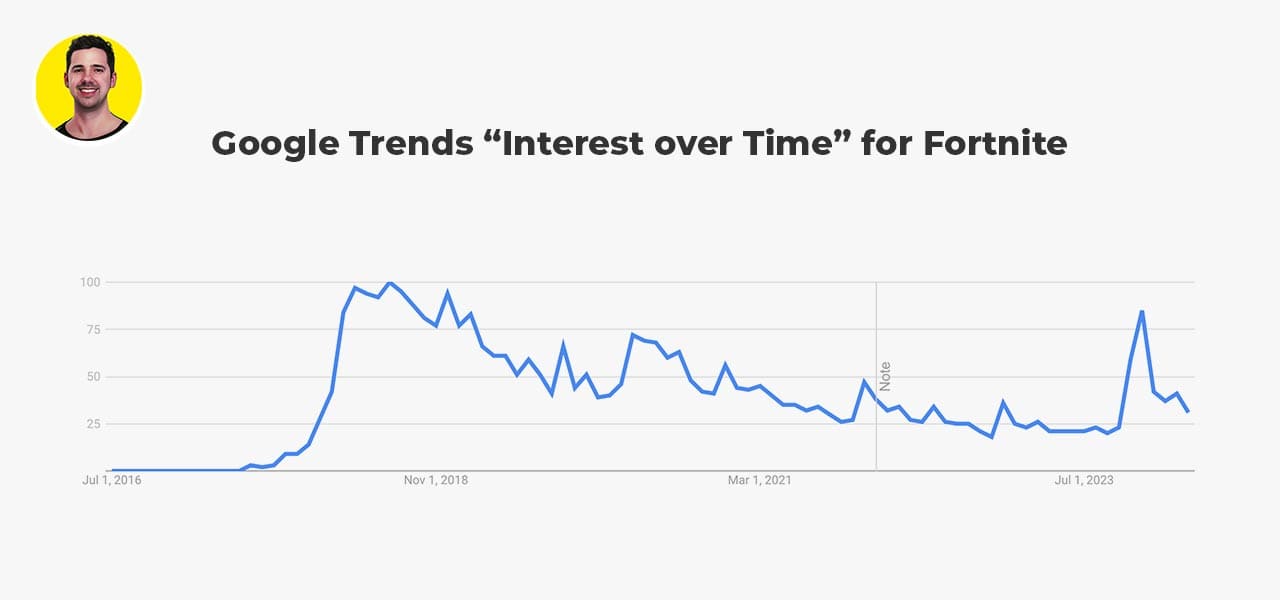
Take the popular game “Fortnite” for example. You can see interest peaked in 2018 a few months after the game was first released.
However, with the exception of one notable spike of interest (that quickly subsided) in December 2023 due to the “Winterfest” update, interest has largely declined.
If your content mostly revolves around that particular interest, even if your video quality has improved, your overall views and audience growth will almost certainly decline. It’s simple maths – there is simply less of an audience available to consume your content.
My videos don’t get recommended.
I remember “back in the good ol’ days” of YouTube (2008-2015), it was totally normal for new channels to simply get zero traction. That’s right – no impressions, no views, no subscribers – nothing. You had to beg your friends, family, and internet strangers to comment on your video and share it to every possible social network.
Of course, that’s still a part of the “newtuber grind” even now.
However, in no small part due to the massive competition they’ve recently begun facing from platforms like Instagram and TikTok, YouTube realized that if they don’t entice new creators onto the platform, they’d rapidly lose market share.
So, about 2 years ago, YouTube actively started trying to expose brand new and smaller channels. You can see this for yourself right now – jump on to your YouTube home page, and I’ll bet you the rest of my half-eaten burrito there’s a video sitting there that has a low amount of views from an unknown or new creator.
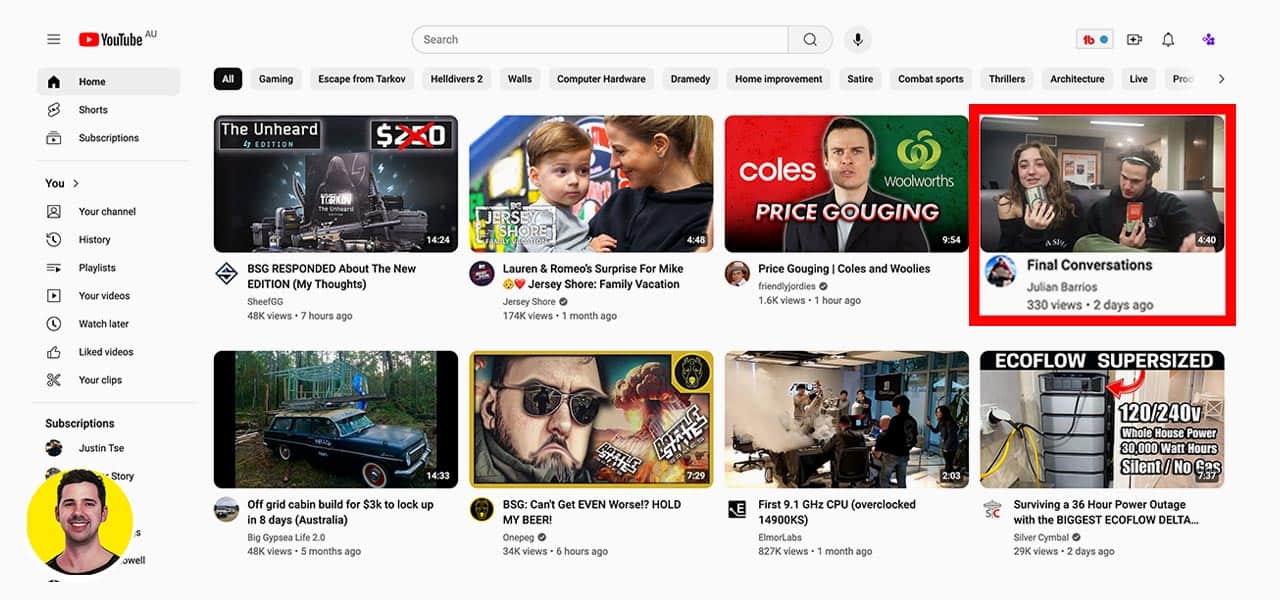
This is my personal YouTube homepage at the time of writing this. You can see 7 out of 8 videos are either from channels I’ve been watching recently, or are already popular videos YouTube thinks I might be interested in based off my viewing behaviour.
But look at the top right corner – a video with only 330 views from a channel with just 11 subscribers (the channel was created in 2018, so not even a “new” channel).
I clicked on the video and it was just two people having a random conversation with poor video and audio quality (no offence to the video poster!). I was not interested in the channel, topic of the video, or video itself, and never would have been.
But YouTube still suggested it to me…
YouTube wants me to try watching new things, it wants to give the creator of that video exposure.
This experience is not unique to me either. YouTube is actively doing this right now with smaller channels. They want these creators to be successful, get views, get subscribers, and contribute to the platform.
There’s just one thing that YouTube needs you to do first… Can you guess what it is?
No one clicks on my videos or watches them.
As I’ve just demonstrated, YouTube WANTS you to succeed. The only problem is – if your video sucks, there’s not much YouTube can do.
Typically when a video is first uploaded, it’s impressed on a “test” audience. This may be a mix of existing subscribers, previous viewers, and new viewers.
The results from this initial “test” will significantly impact the initial trajectory of the video.
As you may already know, there are various “signals” the YouTube algorithm looks for to determine how well a video will perform. In my opinion the “golden triangle” typically includes the click-through rate (CTR), average view duration (AVD), and average percentage viewed (APV).
There are others, of course, but these 3 are some of the most important. And, we can easily see and interpret them within YouTube Studio.
If you have an existing audience, generally some of these stats are inflated at the beginning of a video’s life.
Here’s an example from one of my videos.
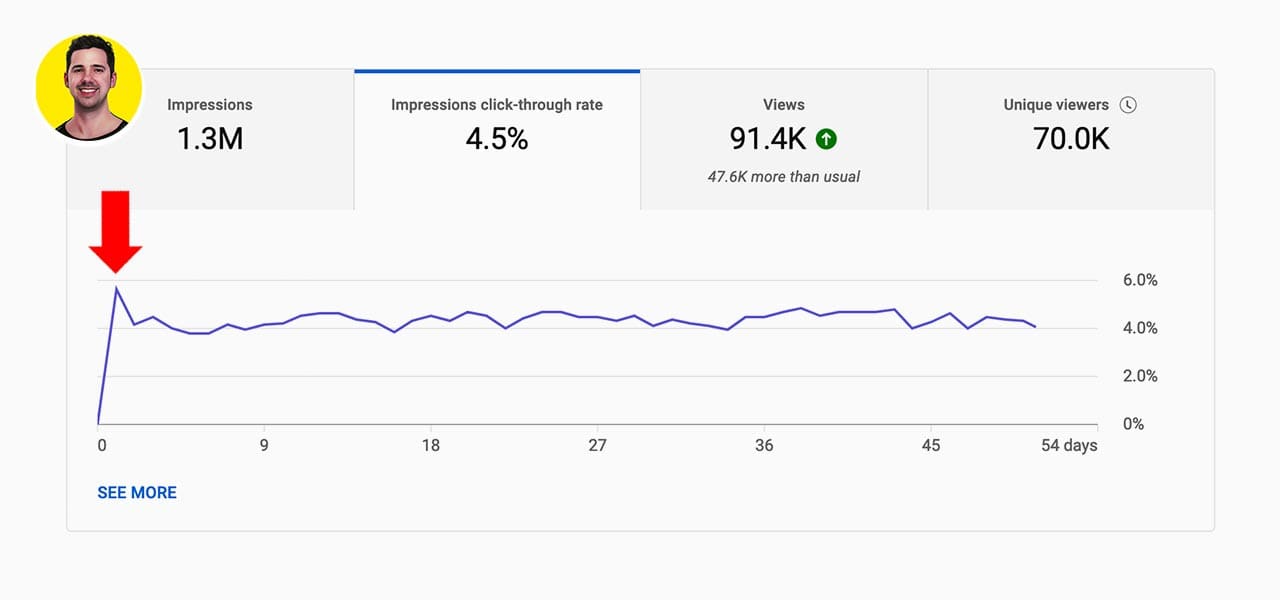
You can see the initial “spike” in click-through rate at the beginning – that’s from my subscribers and long-time viewers recognising my channel and clicking on the new video.
However, the average view duration (AVD) wasn’t that great initially, because some of these viewers realised they weren’t really interested in the video.

But, you can see above that as YouTube continued to test and recommend this video over the next few days, it was able to find the right audience (who importantly also enjoyed the video), and AVD increased over time.
After about 17 days of stagnated performance and testing various audiences, the video had a notable uptick in views. YouTube liked how the video’s “golden trio” signals performed (along with other metrics) and decided to increase the rate of impressions.
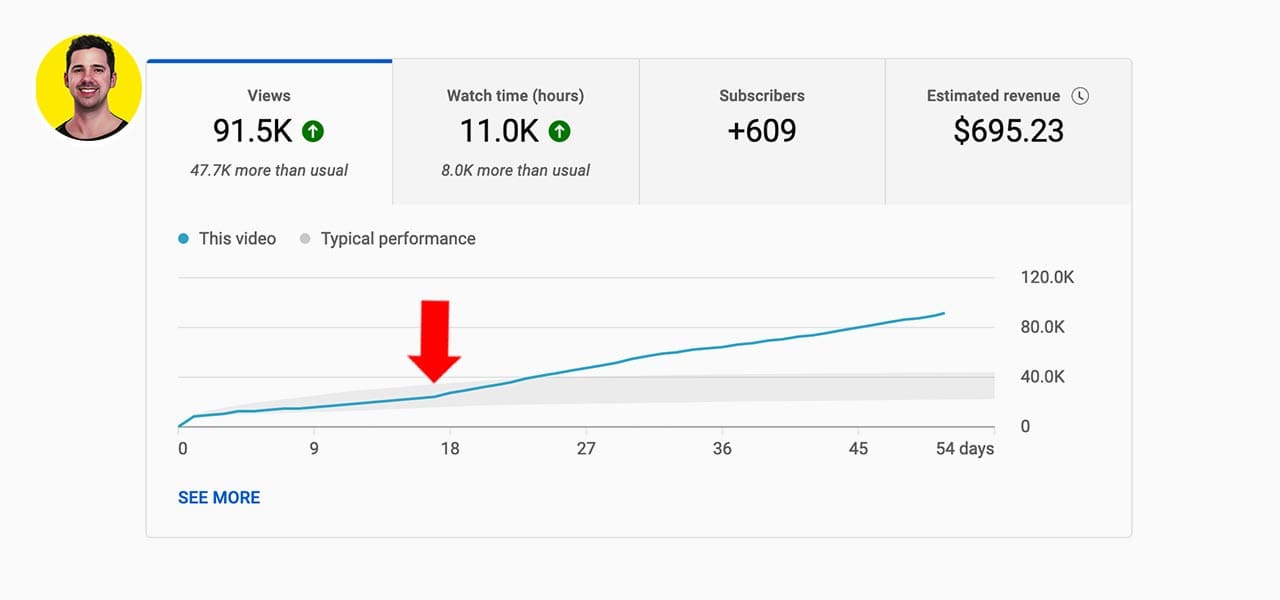
You can see it in the above image. The blue line (total views) starts to break through the grey “typical performance” threshold around the 18-25 day mark.
Overall, this video was a success.
But…
What happens if viewers are recommended a video, but don’t feel enticed to click on it, or even if they do, don’t end up watching a decent amount of it?
That tells YouTube the video isn’t very good.
Depending on how big your existing audience is, it could mean the video just continues to perform poorly and get less views compared to your usual videos. Or, if you’re just starting out and your channel is small, YouTube may just stop recommending the video to viewers altogether, after the initial “testing” period.
And why would they? Why waste precious space on a home screen, or a sidebar recommendation slot on a video that sucks? It’s much better for that precious screen real estate to be used either for a known good video, or a new, untested video that may have potential.
To a new or small YouTuber, it can look like shadow banning. You’ll see some intial impressions, but then it just flatlines and “dies”.
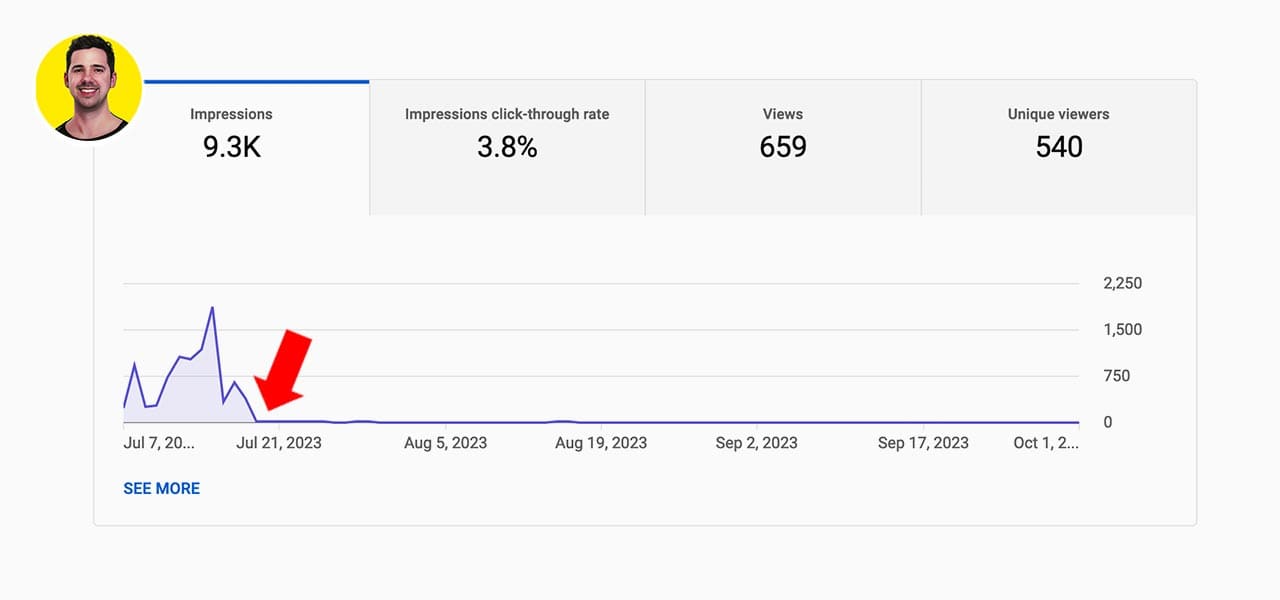
Here’s a video on a new channel I started. You can see YouTube “tested” it via some impressions, the results weren’t great, and so ultimately decided the video sucked and gave up on it.
Overall, this video sucked. It sucked big ol’ donkey balls.
Almost every single video on that new channel had a similar impressions chart. Ouch.
But that’s ok, it still tells me exactly what I need to know. That video ain’t it, so time to go back to the drawing board and try again.
My videos are too good to not get views, it must be a shadow ban
I hear this one a lot too. And look, maybe they are pretty good. Sometimes it can take a really long time to build up traction and gain an audience.
Sometimes the video may even perform really well initially, and then die down. Like this video on another new channel I started.

In the above example, although the video did flatline, it was still a success because it gained almost 70,000 views and performed better than the average video on this channel.
But, if videos are consistently showing a flatlining impressions chart without getting many views, it’s probably because they do, in fact, suck (or there’s just no audience like I mentioned previously).
A lot of new YouTubers fall into the trap of what I like to call “false feedback”. It’s the worst kind of trap too, because it’s just lies.
If you ask your friends or family about your video, they’re not gonna tell you it’s shit.
If you post to YouTuber Discord groups or subreddits and ask for feedback, often it’s either overly polite or not super critical because they don’t want to come across as rude. Or, the feedback is simply complete bullshit because they just want you to critique or check out their channel in return.
This results in a false representation of the quality of your videos.
I see it all the time. A new YouTuber will claim that “everyone loves” their video and they’ve “got a lot of positive feedback”. Then, I go and check out the video, and it’s just not very good, but there are 5-10 comments saying “Awesome video, great job!” from other brand new YouTubers or friends giving encouragement.
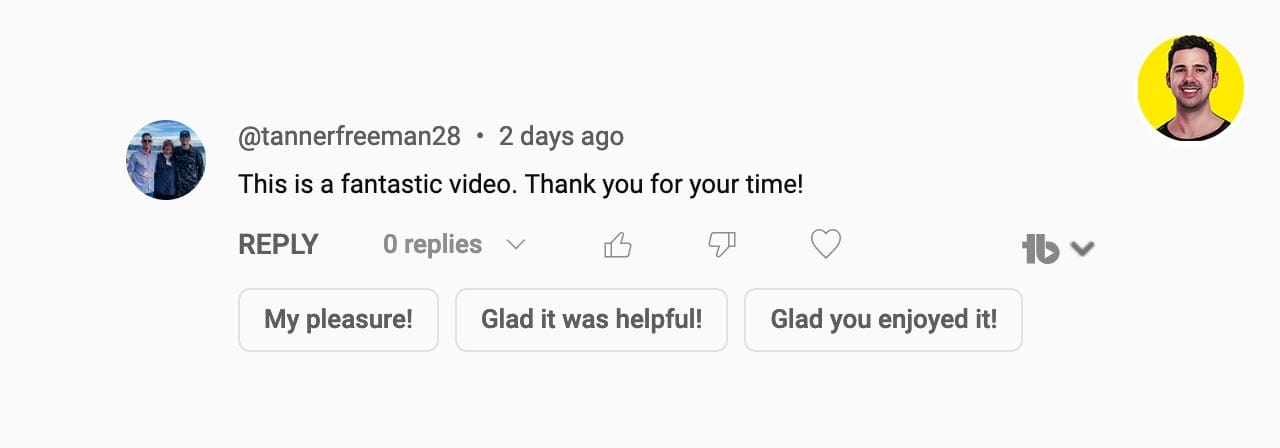
That’s not to say kind words and encouragement are bad, they’re awesome – but they do not necessarily reflect the quality of a video.
Remember – the stats don’t lie. If it’s a good video, you’ll be able to see that in your analytics.
If you want true feedback, you need advice from someone with a similar channel who’s more experienced/successful than you. Ask them to be brutal – literally rip your channel apart.
Only then will you get the feedback you truly need.
Reasons You Might Actually Be “Shadow Banned”
So, let’s cover some factors that may have a negative impact on your channel or videos. Note that this is not technically “shadow banning”, because in each of these instances, there is a very good reason.
Breaching YouTube’s Terms of Service (TOS)
This one is pretty straightforward. For example, when uploading a new video featuring content generated by AI but not clicking “Yes” to YouTube’s “Altered content” checkbox – that’s effectively lying to YouTube.
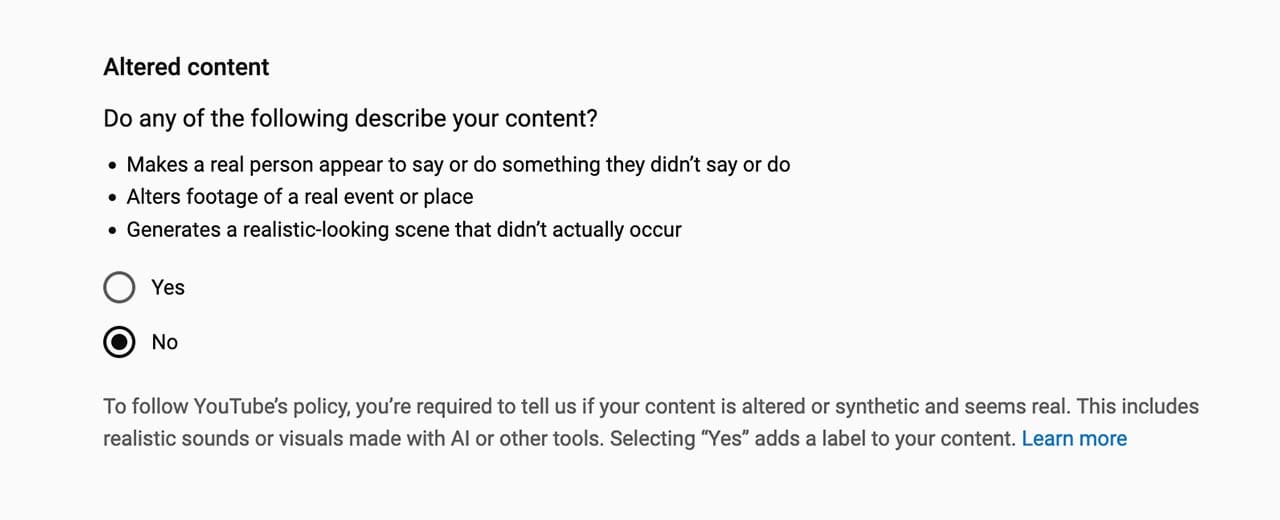
Alternatively, if uploads consistently contain copyrighted content, stolen content, or low-effort content (e.g. a screen recording of a TV show), that just tells YouTube the channel is crap and shouldn’t be recommended to anyone.
YouTube is actually fairly lenient with TOS breaches. They’ll give you multiple warnings or suggestions. At the end of the day, YouTube DOESN’T want to ban you. They want you producing content for their platform that they can slap ads on and make money from.
However, if you continuously breach YouTube’s TOS, even across multiple different channels, don’t be surprised if YouTube takes action.
Major YouTube algorithm changes
I can’t predict how or when the algorithm will change, not even Mr Beast can (although he gets pretty close).
Using him as an example – recently it became apparent that the “Mr Beast” style of insanely edited videos with jump cuts every 2 seconds is becoming outdated.
YouTube (supposedly) calculated that the best way to keep people engaged and on the platform is by watching longer videos with more story-telling elements.
As a result, check out Mr Beast’s most recent video. It’s twice the length of his usual videos with less jump cuts and more story-telling.
Exactly what the algorithm is supposedly looking for (again, we can’t know for sure).
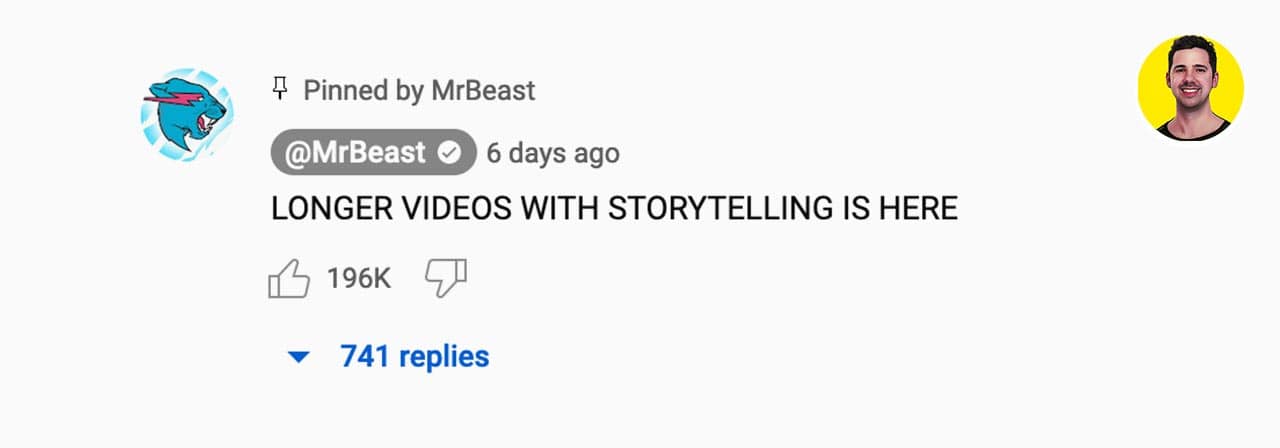
What do you think would happen to his views if he just continued making content in his old style?
This applies to every YouTube channel on the platform.
If you don’t keep up with the changes, you’ll get left behind.
These algorithm changes can manifest in different ways. It could be a slow death where views just steadily decline over time, or an abrupt change where you notice a significant decrease over a few days or weeks.
Refusing to work with YouTube
One day I was scrolling the r/NewTubers subreddit, and I came across a person that claimed he was shadow banned by YouTube. He could not get monetized despite several years of attempts, and his videos received very little views, if any.
The views part was easy enough to decipher – he was reposting low-effort content from other users – nothing original or of high quality.
The monetization part?
Turns out that despite all of his transgressions (breaches of YouTube TOS, possibly even community strikes on multiple different channels), YouTube was still going to allow him to monetize.
However, to enable monetization in YouTube studio, you must have access to “Advanced features”. This requires a verification process, and in some situations, verification can only be achieved via an ID check.
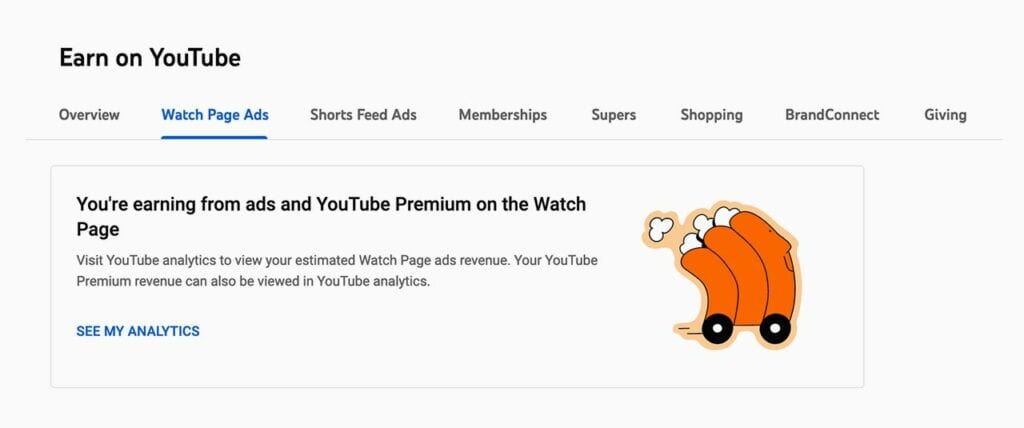
Except, this person “refused to give his personal information to YouTube”… So the ID check could not be completed.
Which is fair enough, I don’t like giving out my personal info either. But it’s their website, so their rules…
The point I’m making is that if someone is claiming they are “shadow banned”, if you actually look into their situation a bit closer, you’ll find a good reason that explains it.
Age-restricted content
If videos contain anything listed in YouTube’s age-restricted content policy, they may become age-restricted. This can have a big impact on impressions and views because:
- Age-restricted videos are not viewable to users who are under 18 years of age.
- If users are over 18 years of age, they must be signed in to an account.
- Age-restricted videos cannot be watched on most third-party websites.
If you upload a video that becomes age-restricted, and you don’t already have a large, loyal following, your video’s performance will likely flatline.
Shadow banned comments
This is probably the only actual instance of “shadow banning” on YouTube. As channel owners, we have the ability to “hide user from channel”.
It’s kind of like a polite version of a ban hammer… Usually reserved for those most polite and exuberant individuals who just cannot help but spray their inner insecurities all over your video.
If you click on a comment, you’ll see it in the drop-down menu.
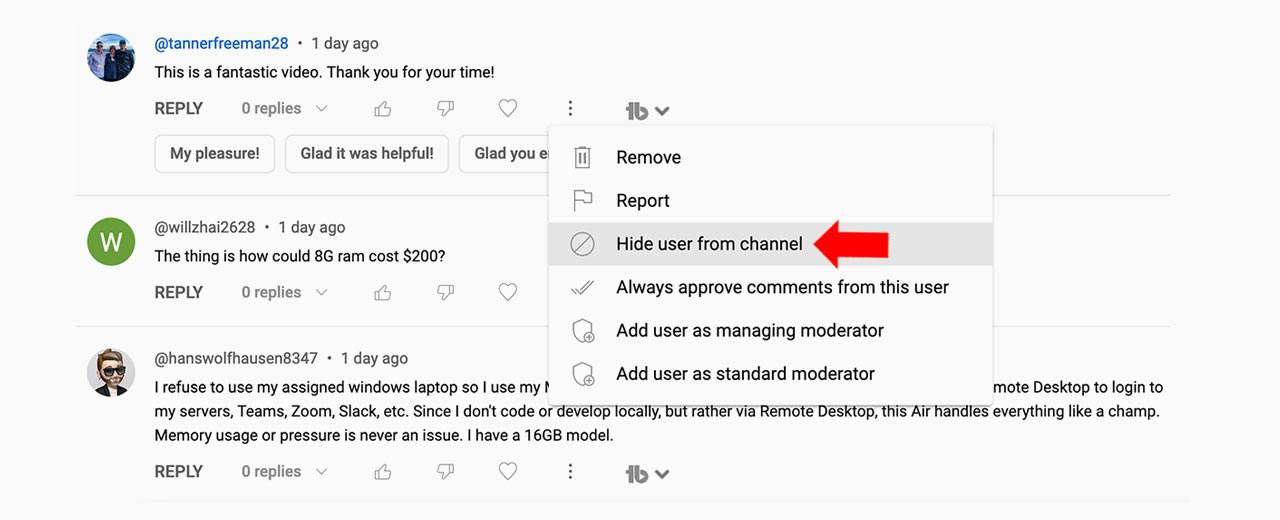
Once hidden, a user can still comment on your videos, and they’ll see their comment, but no one else will (including you).
Many of these people are so petty that they’ll log out, come back to the video, and try to find their comment to check if it’s been hidden or not. It’s kind of pathetic.
Unfortunately, this “Hide” feature seems to make people think that just because “shadow banning” of individual user comments is possible, means that it also applies to entire channels at the click of a button in some disgruntled YouTube employee’s office.
Reporting or analytics glitch
This happens every now and then. Sometimes there’s a software bug or glitch in YouTube’s analytics. It may result in one (or more) of your videos showing zero activity, or no revenue or views for a few hours/days in YouTube Studio.
If this is the case, you can usually find out by going to your local YouTube subreddit or Discord server. If the issue is widespread, other users have likely reported it.
I get this quite frequently on new videos. Sometimes a video just won’t appear in my subscribers’ feeds for a few hours, and I get like 2 comments when I should have 50. Or, the video sits at 500 views for the first 3 hours when usually it would receive around 3000.
Usually after a few hours (for new videos), or a few days (for analytics of older videos) the issue will resolve itself, and your analytics will be back to normal.
Using bots, spamming comments, or faking engagement
I’ll keep this simple – YouTube channels must be as “organic” as possible.
If bots or “fake engagement” services that can be bought online are used (e.g. to generate subscribers, comments, or views), that tells YouTube the channel is not high quality and does not deserve to be recommended.
If a YouTube channel runs around spamming links to their videos on other YouTube videos, that tells YouTube the channel is not high quality and does not deserve to be recommended.
Pro tip: Don’t stuff your description full of keywords either. That’s outdated advice.
Using shadow banning as an excuse
Finally, we get to the most common reason for someone thinking they are “shadow banned”.
Look, I get it. It can be really tough for someone to admit to themselves that after all that hard work, late nights, and time spent trying to grow a channel, that their videos just aren’t good enough (yet).
I went through it too. It took 14 years of me being on YouTube to finally see major success.
But the worst thing you can do is not accept responsibility for your lack of success and use something like shadow banning as an excuse.
Like seriously, who do you think is going to get to $5000 per month quicker – the person who has a tantrum and blames an algorithm for their lack of success, or the person who takes a step back, examines what they’re doing wrong, and adjusts their trajectory to improve it?
I think you know the answer.
So, does Shadow Banning happen? Or is it just a myth?
All the evidence points to it being a myth. I’ve yet to see a good example of a YouTube channel being actively shadow banned for no reason.
95% of the time, the videos just aren’t very good and as a result, do not perform well and are not recommended to YouTube viewers.
The remaining 5% – well, let’s just say the channel has consciously gone down a very specific path that is not beneficial for video views…


